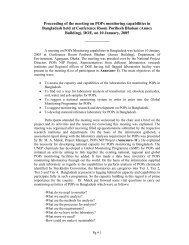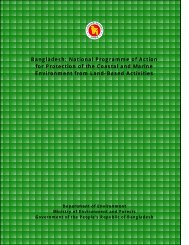Draft CMP HH - the Department of Environment
Draft CMP HH - the Department of Environment
Draft CMP HH - the Department of Environment
Create successful ePaper yourself
Turn your PDF publications into a flip-book with our unique Google optimized e-Paper software.
Coastal and Wetland Biodiversity Management Project BGD/99/G31<br />
Hakaluki Haor <strong>Draft</strong> Conservation Management Plan<br />
7.1.6 Alien Invasive and Exotic Species<br />
Relatively little research has been done to determine <strong>the</strong> presence and impact <strong>of</strong> invasive species on<br />
<strong>the</strong> ecology <strong>of</strong> Hakaluki Haor. Although not currently recognised as serious threat to <strong>the</strong> ECA,<br />
Alien invasive and exotic species have <strong>the</strong> potential to cause major disruptions to <strong>the</strong> Hakaluki Haor<br />
ecosystem and threaten <strong>the</strong> survival its biodiversity. Such impacts are widely documented around<br />
<strong>the</strong> world and it is now widely recognised that <strong>the</strong> best defence is prevention coupled with a<br />
detailed assessment <strong>of</strong> <strong>the</strong> current status <strong>of</strong> invasive species and <strong>the</strong> introduction <strong>of</strong> proper<br />
management regimes.<br />
Introduced Flora<br />
The most common invasive plant species in <strong>the</strong> ECA is <strong>the</strong> aquatic water hyacinth (Eichhornia<br />
crassipes). Originally from Brazil and introduced during <strong>the</strong> British colonial period for its pretty<br />
flower and decorative purposes, it is now found not only throughout Hakaluki Haor, but also all<br />
over Bangladesh. It is a serious invasive which, because <strong>of</strong> its ability to reproduce very quickly,<br />
blocks waterways and displaces indigenous aquatic plant species. The problem is being somewhat<br />
mitigated by local communities who harvest <strong>the</strong> water hyacinth to use as fodder for cattle and as<br />
fertiliser for <strong>the</strong>ir crops<br />
Two species <strong>of</strong> reed (Ipomoea carnia and Ipomoea fistulosa) are also invasive in Hakaluki Haor.<br />
Like <strong>the</strong> water hyacinth, <strong>the</strong>y compete and displace both aquatic and riparian plant species found in<br />
<strong>the</strong> ECA. The problem is exacerbated by local communities who encourage <strong>the</strong> growth <strong>of</strong> <strong>the</strong>se<br />
species as natural hedging or fencing, and for <strong>the</strong> stabilisation <strong>of</strong> soil along <strong>the</strong> banks <strong>of</strong> rivers,<br />
streams, and canals.<br />
The most common exotic flora in <strong>the</strong> ECA include Accia auriculiformis and Acacia mangium,<br />
Samania saman, Mahagoni macrophyla. These species have been introduced and are popular<br />
because <strong>the</strong>y are suited to wetland conditions, grow quickly, and yield good quality hardwood. The<br />
main draw back <strong>of</strong> <strong>the</strong>se species is that <strong>the</strong>y are not <strong>the</strong> preferred habitat for Haor wildlife, and <strong>the</strong>y<br />
are replacing indigenous species <strong>of</strong> swamp forest plants because <strong>the</strong>y are being planted in<br />
preference by <strong>the</strong> local community.<br />
Introduced Fauna<br />
The Irrawady Squirrel (Calloscurus pygerytrus) is <strong>the</strong> most common known invasive animal in<br />
Hakaluki Haor. It seems that it is more prevalent in <strong>the</strong> west <strong>of</strong> <strong>the</strong> ECA where villagers regularly<br />
complain about it eating all <strong>the</strong> fruit from <strong>the</strong>ir gardens. It does not seem to have affected or<br />
displaced o<strong>the</strong>r animal species <strong>of</strong> <strong>the</strong> Haor.<br />
Management Actions<br />
• Identify <strong>the</strong> type and extent <strong>of</strong> exotic species in <strong>the</strong> Hakaluki Haor ECA<br />
• Develop a database to record field information collected on invasive and exotic species<br />
• Develop mechanisms through awareness, education and/ or alternative income generating<br />
activities which help minimise <strong>the</strong> introduction <strong>of</strong> exotic tree species and which encourage <strong>the</strong><br />
planting and regeneration <strong>of</strong> swamp forests<br />
• Monitor <strong>the</strong> ecological and socio-economic impact <strong>of</strong> existing animal and plant invasive species<br />
in <strong>the</strong> ECA<br />
• Control and eradicate, where possible, all introduced animal and plant species that significantly<br />
impact on <strong>the</strong> ecology <strong>of</strong> <strong>the</strong> ECA<br />
• Identify and implement measures to prevent <strong>the</strong> introduction new invasive species<br />
Prepared by UNOPS Consultant Mr. Sulma Warne August/ September 2005 for Project BGD/99/G31 18





